Research examines chemical reactions between human-related
pollution and volatile organic compounds (VOCs) emitted by vegetation
such as trees.-
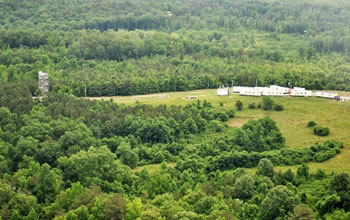 |
| Southeast Atmosphere Study (SAS) tower in the Talladega National Forest in Alabama. Credit: Southeast Atmosphere Study |
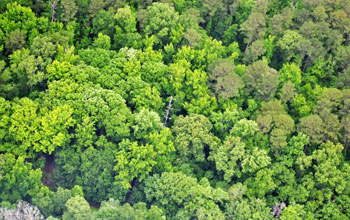 |
| Top-of-tree-canopy view of the SAS instrument tower in the Alabama forest. Credit: Southeast Atmosphere Study |
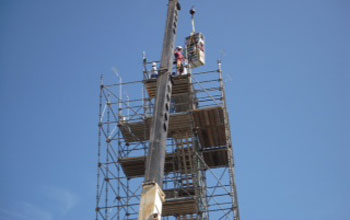 |
| Close-up of the instrument tower being used by SAS atmospheric chemists. Credit: Southeast Atmosphere Study |
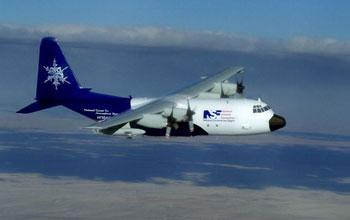 |
| SAS scientists are conducting research aboard the NSF/NCAR C-130 aircraft. Credit: NSF/NCAR |
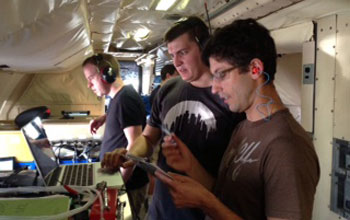
Scientists get ready to fly across the U.S. Southeast in search of air quality discoveries.
Credit: Southeast Atmosphere Study/NOAA
Download the high-resolution JPG version of the image. (43 KB)
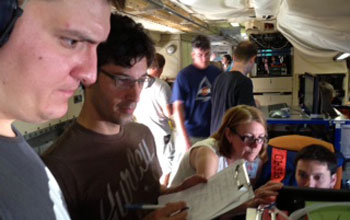
Researchers prepare to sample air chemistry from the skies rather than the ground.
Credit: Southeast Atmosphere Study/NOAA
Download the high-resolution JPG version of the image. (42 KB)
In the largest U.S. atmospheric chemistry field project in decades,
researchers sponsored by the National Science Foundation (NSF) and other
organizations are working to study tiny particles and gases in the air
over the southeastern United States.
The study looks at the
chemical reactions between human-related pollution and volatile organic
compounds (VOCs) emitted by vegetation such as trees in forests.
The
project, called the Southeast Atmosphere Study, or SAS, runs through
July 15, 2013. It's part of an unprecedented campaign, say the
scientists, to investigate the relationship between air chemistry and
climate change.
SAS is supported by NSF, the U.S. Environmental
Protection Agency and the U.S. National Oceanic and Atmospheric
Administration, along with the Electric Power Research Institute.
Participants are from some 30 U.S. and international research
institutions.
Atmospheric chemists have long known that
human-made pollutants have the potential to interact with plant-emitted
VOCs, turning them into airborne particles, or aerosols, that may then
affect air quality and human health.
In the Southeast, the
aerosols also affect the region's climate. The southeastern United
States is one of the few places on Earth displaying an overall cooling
trend over the last century.
"The Southeast Atmosphere Study will
illuminate the role of the surface biosphere in producing volatile
organic gases that can then form new particles, known as secondary
organic aerosols (SOAs)," says Michael Morgan, NSF division director for
Atmospheric and Geospace Sciences.
"The formation of SOAs has
been observed over many forested regions of the world. Emission of these
gases may have an important influence on our changing climate."
Some
scientists believe that enhanced SOA formation may be responsible for
an "aerosol cooling effect" that would explain the divergence of
southeastern U.S. temperature trends from global average temperature
trends over the last century.
Black aerosols produced by industry,
home heating and other means absorb incoming solar radiation,
increasing global temperatures, say scientists such as Ann Marie Carlton
of Rutgers University in New Brunswick, N.J., lead NSF-funded SAS
investigator.
However, many lighter-colored aerosols, such as
those composed of sulfates or organics from vegetation typical of the
Southeast, have a cooling effect because they reflect some amount of
incoming light back to space, says Alex Guenther of the National Center
for Atmospheric Research (NCAR) in Boulder, Colo., also a scientist on
the project.
Some of these aerosols get carried high into the
atmosphere, affecting temperatures over a large area. But many linger
in the region where they were emitted, resulting in more localized
effects.
High concentrations of light-colored aerosols such as
those expected in the Southeast can reduce the average temperature in
the region, offsetting the warming caused by greenhouse gases
circulating around the globe.
But those same aerosols can trigger chemical reactions that worsen air pollution such as ground-level ozone.
Certain
types of aerosols affect cloud formation and cloud opacity; both can
affect the amount of energy trapped in Earth's atmosphere.
Computer
simulations can replicate some of the influences of aerosols. But they
can't yet produce the level of detail required for a complete
understanding of these complex chemical and atmospheric dynamics, which
would lead to more accurate predictions of future air quality and
regional climate.
To address these questions and improve
observations that may be used to expand the capabilities of climate and
chemistry models, SAS investigators are bringing a suite of air sampling
equipment and sensors to the Southeast.
Project scientists are
using two aircraft, the NSF/NCAR C-130 and the NOAA P-3, to sample air
chemistry from the Mississippi River to the Atlantic Ocean, and from the
Ohio River Valley to the Gulf of Mexico.
Researchers are also using ground instruments to measure low-level winds, moisture, temperature and chemistry.
Instrumented towers reaching some 150 feet high are taking measurements within and above forest canopies.
Additional
aircraft and ground sensors deployed by companion programs will help
paint an accurate atmospheric chemistry picture of this unique region.
NSF Southeast Atmosphere Study (SAS) Principal Investigators
Ann Marie Carlton, Rutgers University, New Brunswick:
Collaborative Research: Atmospheric mixed phase chemistry for improved climate predictions: field measurements and modeling of the Southern Oxidant and Aerosol Study
Collaborative Research: Atmospheric mixed phase chemistry for improved climate predictions: field measurements and modeling of the Southern Oxidant and Aerosol Study
William Brune, Pennsylvania State Univ., University Park:
Resolving issues of OH measurements and oxidation chemistry in forest environments
Resolving issues of OH measurements and oxidation chemistry in forest environments
Rodney Weber, Georgia Tech Research Corporation:
Collaborative Research: Atmospheric mixed phase chemistry for improved climate predictions: field measurements and modeling of the Southern Oxidant and Aerosol Study
Collaborative Research: Atmospheric mixed phase chemistry for improved climate predictions: field measurements and modeling of the Southern Oxidant and Aerosol Study
Donald Collins, Texas A&M University Main Campus:
Collaborative Research: Sensitivity of gas and aqueous phase production of secondary organic aerosol to chemical and environmental perturbations
Collaborative Research: Sensitivity of gas and aqueous phase production of secondary organic aerosol to chemical and environmental perturbations
Robert Griffin, William Marsh Rice University:
Collaborative Research: Sensitivity of gas and aqueous phase production of secondary organic aerosol to chemical and environmental perturbations
Collaborative Research: Sensitivity of gas and aqueous phase production of secondary organic aerosol to chemical and environmental perturbations
Delphine Farmer, Colorado State University:
Organic acid concentrations and fluxes over a Southeastern forest during the Southern Oxidant and Aerosol Study
Organic acid concentrations and fluxes over a Southeastern forest during the Southern Oxidant and Aerosol Study
Allen Goldstein, University of California-Berkeley:
Contribution of Biogenic Volatile Organic Compounds to Organic Aerosol Formation in the Presence and Absence of Anthropogenic Pollution
Contribution of Biogenic Volatile Organic Compounds to Organic Aerosol Formation in the Presence and Absence of Anthropogenic Pollution
Jose Jimenez, University of Colorado at Boulder:
Collaborative Research: Investigation of the Effects of Anthropogenic-Biogenic Interactions on Secondary Organic Aerosol Formation
Collaborative Research: Investigation of the Effects of Anthropogenic-Biogenic Interactions on Secondary Organic Aerosol Formation
Douglas Worsnop, Aerodyne Research, Inc.:
Collaborative Research: Investigation of the Effects of Anthropogenic-Biogenic Interactions on Secondary Organic Aerosol Formation
Collaborative Research: Investigation of the Effects of Anthropogenic-Biogenic Interactions on Secondary Organic Aerosol Formation
Frank Keutsch, University of Wisconsin-Madison:
Field and laboratory study of rural VOC oxidation and SOA formation utilizing measurements of formaldehyde and glyoxal
Field and laboratory study of rural VOC oxidation and SOA formation utilizing measurements of formaldehyde and glyoxal
Jesse Kroll, Massachusetts Institute of Technology:
Measurement of Low-Volatility Gas-Phase Organic Compounds during the Southern Oxidant and Aerosol Study
Measurement of Low-Volatility Gas-Phase Organic Compounds during the Southern Oxidant and Aerosol Study
Shan-Hu Lee, Kent State University:
Measurements of Amines During the SOAS (SAS) Field Campaign
Measurements of Amines During the SOAS (SAS) Field Campaign
Paul Wennberg, California Institute of Technology:
Hydroperoxide, Nitrate, and Epoxide Chemistry of Biogenically produced Alkenes
Hydroperoxide, Nitrate, and Epoxide Chemistry of Biogenically produced Alkenes
Xianliang Zhou, Health Research Inc/New York State Health Department:
Collaborative Research: Photolysis of Particulate Nitrate as a Daytime HONO Source and a Re-NOx-ification Pathway in the Troposphere
Collaborative Research: Photolysis of Particulate Nitrate as a Daytime HONO Source and a Re-NOx-ification Pathway in the Troposphere
Jochen Stutz, University of California-Los Angeles:
Collaborative Research: Photolysis of Particulate Nitrate as a Daytime HONO Source and a Re-NOx-ification Pathway in the Troposphere
Collaborative Research: Photolysis of Particulate Nitrate as a Daytime HONO Source and a Re-NOx-ification Pathway in the Troposphere
Daniel Jaffe, University of Washington:
Collaborative Research: The North American Airborne Mercury Experiment
Collaborative Research: The North American Airborne Mercury Experiment
Noelle Selin, Massachusetts Institute of Technology:
Collaborative Research: The North American Airborne Mercury Experiment
Collaborative Research: The North American Airborne Mercury Experiment
Christopher Cantrell, University of Colorado at Boulder:
Collaborative Research: The North American Airborne Mercury Experiment
Collaborative Research: The North American Airborne Mercury Experiment
-NSF-
Media Contacts
Cheryl Dybas, NSF (703) 292-7734
cdybas@nsf.gov
David Hosansky, NCAR (303) 497-8611
David Hosansky, NCAR (303) 497-8611
Related WebsitesSoutheast Atmosphere Study:
The National Science Foundation (NSF) is an independent federal
agency that supports fundamental research and education across all
fields of science and engineering. In fiscal year (FY) 2012, its budget
was $7.0 billion. NSF funds reach all 50 states through grants to nearly
2,000 colleges, universities and other institutions. Each year, NSF
receives about 50,000 competitive requests for funding, and makes about
11,500 new funding awards. NSF also awards about $593 million in
professional and service contracts yearly.
Useful NSF Web Sites:
NSF Home Page:
NSF Home Page:
http://www.nsf.gov
NSF News:
NSF News:
http://www.nsf.gov/news/
For the News Media:
For the News Media:
http://www.nsf.gov/news/newsroom.jsp
Science and Engineering Statistics:
Science and Engineering Statistics:
http://www.nsf.gov/statistics/
Awards Searches:
Awards Searches:
The National Science Foundation (NSF).-
Guillermo Gonzalo Sánchez Achutegui
ayabaca@gmail.com
ayabaca@hotmail.com
ayabaca@yahoo.com
Inscríbete en el Foro del blog y participa : A Vuelo De Un Quinde - El Foro!

No hay comentarios:
Publicar un comentario